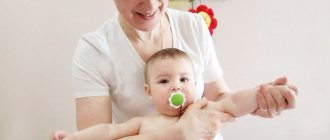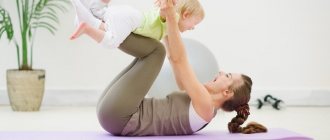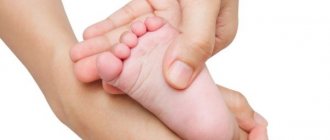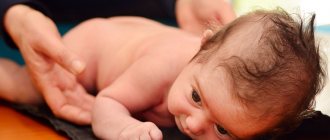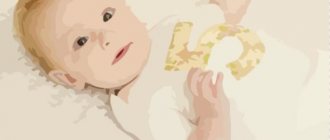What is torticollis?
This is a pathological condition manifested by tilting the head while simultaneously turning to the affected side. This pathology is recorded in 5–12% of newborns. Torticollis can be: congenital, acquired or false (caused by unilateral hypertonicity of the sternocleidomastoid muscle). Symptoms of the disease can be noticed as early as 2 weeks of age.
They appear as follows:
- The baby tilts his head to one side all the time.
- An attempt to tilt the head in the direction opposite to the lesion causes discomfort and crying.
- Asymmetrical position of the shoulder blades.
- When lying on the baby's stomach, an S-shaped curve of the spine is visible.
- The sternocleidomastoid muscle on the affected side is stiff. When you palpate it, you feel a dense cord.
What are the effects of massage for torticollis?
Massage for torticollis is prescribed exclusively by a doctor. The doctor determines which massage technique to choose, the number of procedures and the duration of the break between courses. A properly carried out procedure helps to improve the circulation of lymph and blood in the muscles, which promotes their proper formation, leads to the removal of spasm from the muscle fibers and helps the baby’s head to take the correct physiological position, promotes muscle regeneration (restoration).
No ads 1
Rules
The general rules for massage are as follows:
- The earlier treatment is started, the more effective it is.
- The room for the procedure should be warm.
- The child should be on a flat and hard surface.
- The baby should be fed no earlier than 40 minutes before exposure.
- Hypoallergenic oil or baby cream is applied to the hands of the massage therapist to facilitate gliding. The oil or cream should be warm so as not to cause discomfort to the baby.
- The duration of one session for a newborn is 5 minutes. At the age of 3–4 months, the duration is 5–10 minutes, for children over 5 months – up to 15 minutes.
- Both sides are massaged; on the healthy side the effect is more intense.
- Massage techniques include stroking, light kneading, and gentle vibration.
- After the massage, therapeutic exercises are performed.
- The procedures are carried out 3–5 times a day, in a course of 10–20 procedures. The break between courses is 30–60 days.
Sequence of the preparatory stage
Preparing your baby for massage
Setting up the baby before the massage
How to sterilize baby bottles at home
In order for your baby to receive maximum benefit and relaxation from the massage, you must follow the preparation rules:
- The first sessions are carried out for 15-25 minutes, gradually increasing their duration as the child grows older.
- Hands must be clean and nails trimmed before the session. All jewelry and bracelets have been removed. Babies' skin is very sensitive, so it can easily be injured.
- The session is carried out no less than an hour after the last meal.
Additional Information. The time at which the massage is performed is determined by the parents themselves. To do this, you need to know exactly when the baby is calm and will not become nervous or worried. As a rule, many kids love such procedures most in the morning, when they have had enough sleep and are not hungry.
- Massage to a 3-month-old baby is performed by an adult at home after full training in this practice. Before the session, it is better to watch the training video additionally,
- The massage therapist must be in a good mood, especially if it is mom or dad. The child reads everything and very strongly feels all the emotions of the one who touches him,
- You should not use creams, oils, or powders during the massage. This will only clog the pores in the skin and may even have a negative effect on the entire procedure,
- Before the session, ventilate the room well, and during it, avoid drafts.
- The room temperature should be at least 18-19 degrees, but not higher than 23. Massage for infants from 3 months, as from birth, is always carried out in a warm place,
- During the session, you should tell the baby everything that is happening to him. It would be very appropriate to sing songs or nursery rhymes that are familiar to him. Firstly, this will make him feel calmer (babies understand everything, don’t underestimate them!), secondly, a native voice or a calm, chesty timbre will help the child get positive emotions from the procedure and consolidate further positive results,
- Prepare a changing table or some wide place with a flat surface. It is best to cover it with a thick flannel diaper, lay an oilcloth or absorbent napkin underneath,
- If you need to use oils, for example, if you have dry skin of a baby, then in this case take only natural, plant-based types,
- Prepare the baby himself. Take him in your arms, try to slowly move him with soft, gentle movements along the arms and legs, make sure that the baby is calm and ready for the session, does not experience discomfort, then lay him on the changing table.
The very first year of a baby’s life is an important time for both him and his parents. The baby changes physically and emotionally every month. A massage will help a three-month-old baby not only receive positive emotions, but will also help strengthen the muscular system. If you take care of your child, do massage according to the correct pattern and gymnastics, then subsequently the little fidget will definitely be healthy and strong.
Execution technique
The following describes the main stages of the procedure.
Preparatory stage
This stage allows you to warm up the muscles and ligaments and improve blood circulation. It is important that the child is relaxed and enjoys the procedure. You can turn on pleasant music or simply talk affectionately to the child, which will help the baby distract and calm down, since at first the massage can cause noticeable discomfort.
Treatment of torticollis in infants
Preparation is carried out as follows:
- General body massage with the baby lying on his back. Stroking the chest, abdomen, upper and lower extremities is performed in the direction from bottom to top.
- Once your baby's skin becomes warmer and a rich pink color, you can lightly rub the same areas.
- Working out the joints. Carefully and smoothly rotate the baby's joints clockwise, and then in the opposite direction 2-3 times.
- Raise the child's legs brought together and tilt them alternately in different directions. Gradually increase the angle of inclination. With such movements, the baby will reflexively try to keep the head straight, and the load on the neck muscles will be distributed evenly.
- Bringing the knees to the chest, then turning to the right side, and then to the left.
No ads 3
Main part
At the main stage, the neck muscles are impacted on both the diseased and healthy sides. It must be remembered that large vessels (carotid arteries) pass through this area, so it is better to entrust the massage of a newborn to a massage therapist who specializes specifically in torticollis.
Massage sessions for torticollis, especially the first ones, can cause discomfort and pain to the baby. Parents should be patient and do not stop treatment. Usually after 2-3 procedures the pain goes away. At first, one of the parents can assist the specialist, and when the baby grows up, mom or dad will be able to do the massage on their own
To massage infants, the massage therapist may need an assistant
Technique:
- Massage on the healthy side of the neck. On this side the muscles are stretched, their tone is weakened. Therefore, along with stroking and rubbing, tonic techniques are used: gentle vibration and light tapping.
- Massage the affected side of the neck. Here the effect is aimed exclusively at relaxation: stroking, gentle kneading and very light stretching of the sternocleidomastoid muscle. To perform stretching, the thumbs of both hands need to be placed on the central part of the muscle, and smoothly move them in different directions along its entire length.
- Light cheek massage. On the healthy side, stroking and rubbing are used, on the affected side - stroking and vibration in a downward direction. Impact on the cheeks is used to prevent facial asymmetry.
- The baby is turned over on his stomach and the neck is massaged in this position.
At the main stage, the child’s back is also affected – stroking, rubbing, tapping. Some experts prefer the massage technique in the initial position of the baby on his side. If the torticollis is left-sided, then the child is laid out on the right side, if it is right-sided, then on the left.
[node:field_similarlink]
The final stage
At the end of the procedure, light kneading of the feet and fingers is carried out, since there are many biologically active points in these areas - their massage has a general strengthening effect on the child’s body. Finish the session with light stroking. The child should calm down and relax after fairly intense effects at the main stage of the massage.
When performing a massage, you can turn on pleasant music or simply talk gently to your child. This will help the baby to distract and calm down, since at first the massage can cause noticeable discomfort. You can buy an inflatable ball (fitball) and practice with your child on it.
Considering that the procedures must be done several times a day for a long time, parents should take a massage training course under the guidance of an experienced specialist. It is much easier for the baby to relax when the massage is done by one of the parents, and not by a stranger. If the doctor has prescribed a complex of therapeutic exercises, then it is carried out after the end of the massage session.
If torticollis is severe, it is recommended to massage in warm water (temperature 36 degrees), this will help relieve muscle spasm faster
Massage and gymnastics for the hands of a child 1-3 months old
Normalizing the muscle tone of the arms is no less important. Long-term changes in muscle tone will prevent the child from mastering the first conscious motor skills, in particular such as leaning on the forearms, straightening the arms while lying on the stomach, and pulling the arms towards toys. Massaging the palms and fingers will enable the baby to quickly and correctly open the fist and move the thumb away from the palm in order to quickly grasp the toy correctly.
- We start with a finger massage. We rub each of the baby's fingers with the pads of our fingers, moving progressively from the tip to the base of the baby's finger. Repeat 1-2 times
- We pay special attention to the thumb. We move it away from the palm several times, holding it in this position for a short time.
- We stroke the child's palm in a circle, from top to bottom.
- We rub the forearm with progressive spiral movements towards the elbow.
- We rub the shoulder with progressive spiral movements towards the shoulder. If a child has a mark on his arm from the BCG vaccination, it should be avoided.
- Bend the child’s arm at the elbow 4-6 times. In this case, the hand should be perpendicular to the baby’s body.
As a rule, children like exercises with pens less and they begin to show some dissatisfaction. Therefore, accustom your baby to hand gymnastics gradually, starting with a small number of repetitions. Perform the movements clearly and without hesitation.
- Raise and lower the baby's arms, together and separately. We try to make the child's arm bend at the shoulder joint, and not at the elbow. Considering that at this age the tone in the baby’s arms is still quite strong, it is better to lift the arms one at a time, holding the body with the other hand.
- We spread the baby's arms to the sides, and then cross them on the chest. When crossing, either the right or the left hand should be on top. In this case, your thumb should be placed in the child’s palms.
- We again put our thumbs in the baby’s palms, and with the rest of our fingers we grab the handle from the outside. We slowly pull the baby towards us by the hands. The child should grab your fingers tightly and try to pull himself up. It is necessary to achieve active tension in the flexor muscles of the child’s arms.
This exercise is recommended for children aged 2 months and older who can already hold their heads. For those who do this hesitantly, you can hold your head from behind with your palm.
As a result of this exercise, the child should group himself, raise his head and bend his elbows. It is enough for the baby to rise to a semi-vertical position; there is no need to completely sit the child down.
Impact by position
When the child is 2 months old, positioning treatment is used. This method requires patience and perseverance on the part of the parents. It involves placing the baby in such a way as to encourage him to look in the direction opposite to the one affected. Bags filled with sand or coarse salt will help fix the head in the correct position.
When parents carry a child in their arms, they need to hold the child's head with their cheek so that it does not tilt to the affected side. While swimming, you can use a special inflatable ring to support your neck. It is important to remember that while bathing, babies should experience positive emotions and be relaxed. During sleep, you should alternately turn the baby's head in one direction or the other.
Up to one year of age, problems with torticollis are not very noticeable, but as the child grows, so do the problems, which can ultimately lead to surgical intervention.
In order to prevent dangerous manifestations (atrophy of the neck muscles, scoliosis of the cervical and thoracic spine, underdevelopment of the facial skeleton), parents should consult a doctor in time and strictly follow all recommendations. Massage is an effective means of preventing and treating many problems of the musculoskeletal system in newborns, including torticollis.
Why do you need a massage?
How to prepare for the birth of your baby
Pediatrician Evgeny Komarovsky strongly recommends massage for infants for 3 months. The doctor suggests doing it at home or turning to professionals. Currently, the cost of a service with a massage therapist visiting your home in Moscow clinics varies between 1000-1500 rubles per session[1]. First of all, from such a procedure, if everything is done correctly, the baby will receive a great charge of energy and positive emotions.
Baby's positive emotions from massage
Massage procedures are invaluable for the physical and intellectual development of a baby. During massage, the nervous system is stimulated, most of the receptors and nerve endings that are present on the child’s skin are irritated. It is these receptors, when stimulated, that send certain signals to the brain, prompting the nervous system to work.
Benefit for health
Massage for a 3 month old baby brings great benefits to him:
- Improves blood circulation,
- Develops tactile sensations - touches help him begin to understand the world around him,
- Improves psycho-emotional state, reduces excitability and increased muscle tone,
- Strengthens the baby's immunity,
- Helps minimize or eliminate the presence of colic,
- Develops the musculoskeletal system: establishes the formation of correct posture, corrects the presence of torticollis, corrects clubfoot and even deformation of the lower extremities. Optimal physical shape is formed or restored,
- Helps to carry out preventive actions to prevent the occurrence of various diseases,
- Improves sleep, helps to eliminate the baby's whims, especially during teething.
Note! You should always contact a professional, especially when it comes to therapeutic massage. Don’t be afraid to ask to see a certificate of education in this field. Otherwise, you can cause irreparable harm to the baby. It is also important to monitor what the room temperature is. If the temperature regime is not observed, the baby may freeze or, conversely, sweat too much and lose the fluid necessary for the body.
There are a number of contraindications for which massage should not be performed:
- Acute viral infection, cold, high fever,
- Skin diseases
- Problems with the baby's circulatory system,
- If the baby is nervous, worried, screams, and shows with all his actions that this is unpleasant for him,
- The presence of any kind of disease in the acute stage,
- Presence of an umbilical hernia. It is imperative that a pediatrician be present in such cases so that he can prevent it from becoming pinched,
- Presence of heart disease. The presence of a cardiologist is required.





